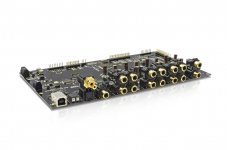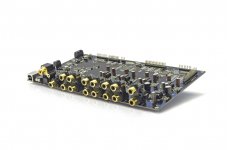SAC - a quick google search shows that the output impedance of your Oppo BDP 83 (?) is c.100 ohms. Have a look at Rod Elliot's esp pages - there's an article on voltage dividers/attenuators with the formulae you need to use. But 8k will not be suitable for your case. It's what I need to use because of my tube phono stage's high output impedance - it's really not ideal and I really need Najda's input impedance to be 50k, but that's not an option.
Stephen
Stephen
Sorry, the quote was from someone else. I do not have an Oppo83, but an old Sony350.
Thanks Stephen, but I do not have an Oppo. I think I am settled in my gain journey now anyway. The first priority was to get the analogue input barely clipping on the Najda, and I have that now. I am using -3db on the Najda input gain setting.
How did I get here? Having come across transformer attenuators in my research and discovering they are widely held as superior to a resistor network, for example;
"The transformer attenuator addresses the problem of attenuation by using a transformer rather than a resistor to decrease voltage. A transformer can take a high-voltage, low-current signal and convert it into a low-voltage, high-current signal of the same energy (minus some small losses in the transformer). Hence, you get the decrease in voltage that you need to lower volume while losing next to none of the signal’s energy. Instead of demolishing the signal and then resuscitating it actively, voltage is exchanged for current to achieve the desired result. Impedance between the source and the amplifier are matched in a manner similar to the way the transmission in your car matches the high-rpm/low-torque output of the engine to the low-rpm/high-torque rotation at the wheels. Best of all, the process occurs in a single step using a single passive component."
Since the Najda replaced a 4way PLLXO, I had some nice OEP transformers now doing nothing. I put them in reverse and by luck the Najda barely clips on one or two channels so far, hence the -3db. I think I'll leave it at this.
Why does my reference bluray (Akira) sound so much better now? Was the resistor gain network killing the sound, was it the bass xover/PEQ change I made, was it the addition of a rear tweeter, or a combination of all? Anyway, fantastic sound now. Big thanks to Nicholas and the help of other contributors on this thread!
Last edited:
FIR on NUC
I started on my Najda DSP FIR implementation and find interesting idea from one forum: JBL Master Reference Monitor - Page 36
Is possible to implement same on Najda hardware?
I understand this different decimation (down-clocking) on different channels/bands can help to overcome lack of taps and/or processing power.
I started on my Najda DSP FIR implementation and find interesting idea from one forum: JBL Master Reference Monitor - Page 36
Is possible to implement same on Najda hardware?
I understand this different decimation (down-clocking) on different channels/bands can help to overcome lack of taps and/or processing power.
I started on my Najda DSP FIR implementation and find interesting idea from one forum: JBL Master Reference Monitor - Page 36
Is possible to implement same on Najda hardware?
I understand this different decimation (down-clocking) on different channels/bands can help to overcome lack of taps and/or processing power.
Hi Meelis,
Your understanding of the decimation benefits is correct, and I confirm decimation is in the pipeline for the Najda.
Best,
Nick
CS3318 volume control gain
More questions: on CS3318 datasheet is information that volume control range is 96 dB and gain control range is 22 dB. On NUC is volume rang 96 dB and gain control -15 to + 15 what is 30 dB. How this 30 dB is achieved on Najda if CS3318 provide only 22 dB?
More questions: on CS3318 datasheet is information that volume control range is 96 dB and gain control range is 22 dB. On NUC is volume rang 96 dB and gain control -15 to + 15 what is 30 dB. How this 30 dB is achieved on Najda if CS3318 provide only 22 dB?
This sound good for FIR users, then bass and middle channels can also use decent number of taps.Your understanding of the decimation benefits is correct, and I confirm decimation is in the pipeline for the Najda.
More questions: on CS3318 datasheet is information that volume control range is 96 dB and gain control range is 22 dB. On NUC is volume rang 96 dB and gain control -15 to + 15 what is 30 dB. How this 30 dB is achieved on Najda if CS3318 provide only 22 dB?
Meelis, the CS3318 can indeed provide up to 22 dB of gain if this is compatible with the input signal magnitude and the supply voltage of the chip itself.
In the Najda, you have up to 15 dB of gain on a signal nominally 1 Vrms, and this brings the signal to nearly 6 Vrms - which is the max the chip can output with +/- 9V supplies.
For the remaining of your question related to how gain and volume are managed across the whole range, the datasheet details several registers that you can use for setting gains and attenuation.
VFD that might work (its the same as was mentioned earlier in this thread)
VFD on AdaFruit I2C LCD Display Shield adafruit industries blog
The Noritake CU16025-UW6J is documented to work with adafruit´s LCD shield.
The LCD shield does two things: provides an I2C interface to LCDs and provides lots of buttons. So it frees up the precious GPIOs on the Arduino to do other things. The interesting thing however, is that the shield does not know if it is an LCD or a VFD connected. My conclusion is that this might be a VFD that works well with the Najda.
BTW. The Noritake CU16025-UW6J is marketed as a plug-in replacement for LCDs, with the same form factor.
"Command compatible with HD44780 LCD controller Display ON/OFF
Brightness Control
Cursor ON/OFF
8 User definable character font
etc."
It is expensive, but it will look amazing. Will see if I find somebody that ships this to Norway.
Will see if I find somebody that ships this to Norway.
VFD on AdaFruit I2C LCD Display Shield adafruit industries blog
The Noritake CU16025-UW6J is documented to work with adafruit´s LCD shield.
The LCD shield does two things: provides an I2C interface to LCDs and provides lots of buttons. So it frees up the precious GPIOs on the Arduino to do other things. The interesting thing however, is that the shield does not know if it is an LCD or a VFD connected. My conclusion is that this might be a VFD that works well with the Najda.
BTW. The Noritake CU16025-UW6J is marketed as a plug-in replacement for LCDs, with the same form factor.
"Command compatible with HD44780 LCD controller Display ON/OFF
Brightness Control
Cursor ON/OFF
8 User definable character font
etc."
It is expensive, but it will look amazing.
I have this model on the bench. I'll test it tomorrow and I'll let you know how it goes. It's supposed to be compatible with the HD44780 so we'll see.
It doesn't seem to be Noritake-branded - at it's actually much cheaper.
It doesn't seem to be Noritake-branded - at it's actually much cheaper.
In the Najda, you have up to 15 dB of gain on a signal nominally 1 Vrms, and this brings the signal to nearly 6 Vrms - which is the max the chip can output with +/- 9V supplies.
I not fully understand as on Najda I can also reduce gain by 15 dB what makes full gain range 30 dB, but CS3318 can only provide 22 dB gain range.
Alright, I've tested the above mentioned VFD and it's not compatible.
The range -15 dB to 0 dB must be understood as attenuation.
Only the range 0 dB to 15 dB effectively boosts the signal. The CS3318 specs mean that there's provision for boosting the signal by up to 22 dB if that's compatible with the final signal magnitude vs the supply rails.
Hope this helps
I not fully understand as on Najda I can also reduce gain by 15 dB what makes full gain range 30 dB, but CS3318 can only provide 22 dB gain range.
The range -15 dB to 0 dB must be understood as attenuation.
Only the range 0 dB to 15 dB effectively boosts the signal. The CS3318 specs mean that there's provision for boosting the signal by up to 22 dB if that's compatible with the final signal magnitude vs the supply rails.
Hope this helps
I will try the Noritake anyway, and let you guys know how it goes. I figure that the Arduino shield uses a 100% compliant hd44780 protocol, so if it wont work on the Najda, it should be possible to tweak the timings etc to improve hd44780 compliance (with no negative effects for existing users) in the Najda firmware. After all, that shield works with both noritake vfd (specifically built to be a plug-in vfd replacement) and regular hd44780 lcds. Most VFDs require changes in communication vs an LCD, but that particular model is documented to not require this.
Still not clear.The range -15 dB to 0 dB must be understood as attenuation.
Only the range 0 dB to 15 dB effectively boosts the signal. The CS3318 specs mean that there's provision for boosting the signal by up to 22 dB if that's compatible with the final signal magnitude vs the supply rails.
As I understand from CS3318 datasheet, if volume control is used in range 0 to -96 dB, then gain is possible only as boost 0 to +22 dB. On CS3318 diagram image below is gain controlled with negative feedback and it is not possible to get gain less than 1 (attenuation or gain less than 0 dB) accordingly this diagram.
But how still is gain attenuation obtained on Najda?
An externally hosted image should be here but it was not working when we last tested it.
Last edited:
- Home
- Source & Line
- Digital Line Level
- DSP Xover project (part 2)

